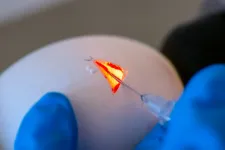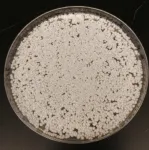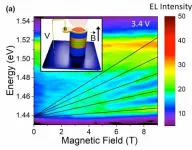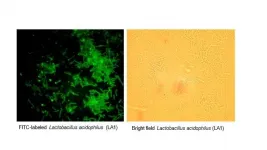Biologists discover a new type of placental structure in animals
The Cyclostomata is an ancient group of aquatic colonial suspension-feeders from the phylum Bryozoa. The fact that they have unique placentae has been discovered by researchers.
2021-04-20
(Press-News.org) The Cyclostomata is an ancient group of aquatic colonial suspension-feeders from the phylum Bryozoa. The fact that they have unique placentae has been discovered by researchers at St Petersburg University and the University of Vienna. The coenocytes, i.e. large multinucleate cell structures, originate via nuclear multiplication and cytoplasmic growth among the cells surrounding the early embryo. Interestingly, the coenocytes are commonly found among fungi and plants, yet are quite rare in animals. It is the first time coenocytes have been discovered in placenta.
Biologists are well aware that the cells of the living organisms are incredibly different in the way that they behave. They may happen to form a multinucleate structure resulting from cell fusion, i.e. so-called syncytium with a single membrane. Such 'behaviour' ensures nutrient circulation with no resources and time spent on transporting between the cells. Yet similar structures can be formed through ways other than fusion, e.g. coenocytes originate via nuclear multiplication and cytoplasmic growth. Cell fusion is mainly typical of animals. For instance, in human placenta, syncytium covers embryonic placental villi, which invades the wall of the uterus to establish nutrient circulation between the embryo and the mother. In contrast, formation of coenocytes is typical of plants and fungi. Yet what these processes - cell fusion and cell growth, have in common is that they result in quite large irregular structures that resemble tissues.
'Initially, my postgraduate student Uliana Nekliudova, who is the first author of the article, and I expected to see syncytium in the Cyclostomata. Yet what we came across was coenocytes, i.e. multinucleate structures that were previously unknown in animal placentas,' said the head of the project and Professor at the Department of Invertebrate Zoology at St Petersburg University Andrew Ostrovsky. 'The embryos in this group of Bryozoa are not just abut the placenta, as happens normally, but embedded into it. The placenta consists of several large coenocytes, and the coenocytic "elements" are interconnected via cytoplasmic bridges and various cell contacts. Coenocytes have different ultra-structure. This tissue shows evidence of both nutrient synthesis and transport.'
Additionally, as the scientist said, forming such a structurally complex placenta may have contributed to evolving polyembryony in this group of animals. Polyembryony is a condition in which over a hundred embryos develop from a single fertilised egg, forming larvae. Yet, the unique combination of placentation, viviparity, and polyembryony is known to occur only in the nine-banded armadillo Dasypus.
The samples were collected near the Marine Biological Station of St Petersburg University at the White Sea. The scientists also discovered that placentation originated from the organ that was responsible for pushing off tentacles. All bryozoans release sperm into water column where zooids from other colonies catch it using tentacles. The membranous sac, i.e. an organ that contains circular muscles, pushes the tentacles off. After internal fertilisation, the membranous sac becomes part of the placenta transforming to coenocytes that provide embryonic nourishment. Evolution of the cyclostome placenta, involving transformation of the hydrostatic apparatus (membranous sac) and substitution of its function to embryonic nourishment, is an example of exaptation.
Most bryozoans eject a fertilised egg and then transport it into a special brood cavity for incubation. Yet the cyclostome bryozoans do it differently. The larvae develop inside the gonozooids, i.e. colony members that serve as a placental incubator. Larval production lasts almost all summer. Developed larvae gradually leave the gonozooids.
'Polyembryony is a so-called evolutional dead-end. You have offspring, yet they are clones. There is no genetic diversity', said Andrew Ostrovsky. 'The fact that the offspring are different is essential for the ability to survive. The question is why is polyembryony - that has been typical to Cyclostomata for about 200 million years according to the fossil evidence we have - resisted? What is the catch? Presumably, the bryozoans, producing clone-larvae during several months, "collide" them with a constantly changing environment. As a result, it is not genomes that change, but conditions where these genomes happen to find themselves.'
INFORMATION:
[Attachments] See images for this press release:
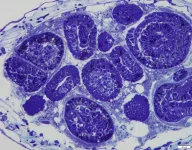
ELSE PRESS RELEASES FROM THIS DATE:
2021-04-20
Targeted therapy in early stages of breast cancer can pave the way for a notable higher success rate, shows a study from the University of Bergen, Norway (UiB).
PARP (Poly (ADP-ribose) polymerase) inhibitors represent an established targeted therapy for multiple cancer types, including cancers of the prostate, ovary and rare cases of breast cancer.
PARP inhibitors take advantage of defects in a central mechanism of DNA damage repair, observed in these cancers. While such compounds have been successfully applied in ovarian and prostate cancers, to this end only a small minority of patients with breast ...
2021-04-20
Researchers at the TUM have demonstrated a way to efficiently study molecular mechanisms of disease resistance or biomedical issues in farm animals. Researchers are now able to introduce specific gene mutations into a desired organ or even correct existing genes without creating new animal models for each target gene. This reduces the number of animals required for research..
CRISPR/Cas9 enables desired gene manipulations
CRISPR/Cas9 is a tool to rewrite DNA information. Genes can be inactivated or specifically modified using this method. The CRISPR/Cas9 system consists of two components.
The gRNA (guide RNA) is a short sequence that binds specifically to the ...
2021-04-20
Although the problem of gender discrimination is already found in the music industry, music recommendation algorithms would be increasing the gender gap. Andrés Ferraro and Xavier Serra, researchers of the Music Technology research group (MTG) of the UPF Department of Information and Communication Technologies (DTIC), with Christine Bauer, of the University of Utrecht (Netherlands), have recently published a paper on gender balance in music recommendation systems in which they ask themselves how the system should work to avoid gender bias.
At the outset, the authors identified that gender justice was one of the artists' main concerns
Initially, the work by Ferraro, Serra and Bauer ...
2021-04-20
MINNEAPOLIS/ST.PAUL (04/20/2021) -- University of Minnesota Medical School researchers have offered new ways to think about the immune system thanks to a recent study published in END ...
2021-04-20
PHILADELPHIA - Renter protection policies that have curbed mass evictions during the COVID-19 pandemic have played a key role in preventing the spread of SARS-CoV-2 in U.S. cities, according to a new study published in Nature Communications.
Using an epidemiological model to predict how evictions and eviction moratoria would impact the epidemic, the researchers found, for instance, that in a city of 1 million in which 1 percent of households experience eviction monthly, this could lead to up to 49,000 excess COVID-19 infections. In Philadelphia alone, a fivefold increase in ...
2021-04-20
An overgrowth of yeast in the gut within the first few months of life may cause changes to the immune system that increase the risk of asthma later on, shows a study published today in eLife.
Asthma is a common and sometimes difficult-to-manage, life-long lung condition that affects one in 10 children in developed countries. The findings explain a possible cause of asthma and may help scientists develop new strategies to prevent or treat the condition.
The period just after birth is a critical window for the development of a healthy immune system and gut microbiome. ...
2021-04-20
Charcot Marie Tooth and Dejerine-Sottas syndrome are groups of diseases that involve the breakdown of the myelin sheath covering nerve axons.
As this myelin sheath breaks down, people who have these disorders suffer nerve damage in the arms and legs--those with Dejerine-Sottas disease may never walk or may lose the ability to walk by the time they are teenagers.
Researchers have known that a protein called PMP22, which is important for nerve myelin, is likely involved in the disease. But because the protein is so small and part of the cell membrane, ...
2021-04-20
Scientists have produced a comprehensive roadmap of muscle aging in mice that could be used to find treatments that prevent decline in muscle mobility and function, according to a report published today in eLife.
The study reveals which molecules in the muscle are most significantly altered at different life stages, and shows that a molecule called Klotho, when administered to mice in old, but not very old, age, was able to improve muscle strength.
Age-related loss of skeletal muscle mass and function - called sarcopenia - is associated with loss of mobility and increased risk of falls. Yet, although scientists know how sarcopenia affects the appearance and behaviour of muscle tissues, the underlying molecular mechanisms for sarcopenia remain poorly understood. Current treatments ...
2021-04-20
Diodes are widely used electronic devices that act as one-way switches for current. A well-known example is the LED (light-emitting diode), but there is a special class of diodes designed to make use of the phenomenon known as “quantum tunneling”. Called resonant-tunneling diodes (RTDs), they are among the fastest semiconductor devices and are used in countless practical applications, such as high-frequency oscillators in the terahertz band, wave emitters, wave detectors, and logic gates, to take only a few examples. RTDs are also sensitive to light and can be used as photodetectors or optically active elements in optoelectronic circuits.
Quantum tunneling (or the tunnel ...
2021-04-20
Philadelphia, April 20, 2021 - Intestinal epithelial tight junctions (TJs) act as a functional and structural barrier against harmful antigens that promote intestinal inflammation in inflammatory bowel disease (IBD) and other inflammatory conditions of the gut. A defective intestinal TJ barrier, sometimes known as "leaky gut," plays an important role in exacerbating and prolonging intestinal inflammation. New research reported in The American Journal of Pathology, published by Elsevier, shows that the probiotic Lactobacillus acidophilus (L. acidophilus) strain known as LA1 can generate a rapid and sustained enhancement of this defective intestinal barrier and effectively treat intestinal inflammation by preserving and restoring ...
LAST 30 PRESS RELEASES:
[Press-News.org] Biologists discover a new type of placental structure in animals
The Cyclostomata is an ancient group of aquatic colonial suspension-feeders from the phylum Bryozoa. The fact that they have unique placentae has been discovered by researchers.

